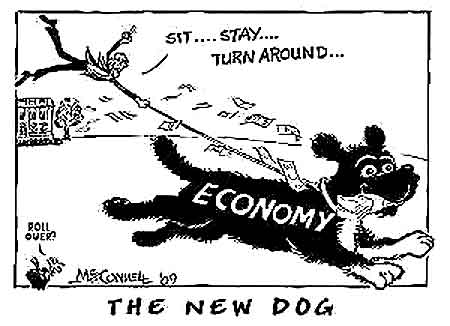|
Cartoons of
Dan McConnell
featuring
Tiny the Worm
Cartoons of
David Logan
The People's Comic
Cartoons of
John Jonik
Inking Truth to Power
|
Support the WA Free Press. Community journalism needs your readership and support. Please subscribe and/or donate.
posted July 24, 2009

cartoon by Dan McConnell
Stock Slump Means Huge Tax Bailout for ‘Investors’
By Gerald E. Scorse
You think investors had it bad last year? You may not know it, but they’ll be turning to America’s taxpayers (as they always do) to help bail them out.
Every spring, thanks to a generous tax code provision, the Treasury picks up part of the tab for losing bets on Wall Street. Given last year’s historic plunge, these personal bailouts could rival the $700 billion TARP bailout—and for investors, there’s no dollar cap or cut-off date.
It all adds up to an extended fiscal hit on the Obama Administration. No matter how large the losses realized in 2008, no matter how long it takes to recoup, Uncle Sam will be sharing the pain. Deeply sharing: up to 35 percent depending on the loser’s tax bracket, or 39.6 percent if Obama ends the Bush tax cuts for higher-income Americans.
Capital loss offsets are the tax code provision that soothes investor wounds. When the year’s trades are reported on tax returns, losses offset taxable gains dollar-for-dollar. If net losses exceed gains, the loss offsets taxable income—by up to $3,000—and provides another tax saving.
Offsets never lose their tax-reducing power. Losses greater than $3,000 (as last year’s probably were) are carried forward indefinitely until they’re used up.
At 15 percent, the tax on long-term capital gains is low compared to the rate on ordinary income like wages. With capital loss offsets, the deal is even sweeter on the downside. While gains are taxed at less than half the top rate, losses are written off at 100 percent across the board. Could losing come any closer to winning?
Yes, say Senator John McCain and Michael Boskin, a former chairman of the Council of Economic Advisers. Senator McCain proposed raising the capital loss offset against ordinary income from $3,000 to $15,000 per-year for 2008 and 2009. Boskin would up the number to $20,000.
All of which raises some interesting questions. Who profits from these write-offs? Is there good reason for the government (read: taxpayers) to subsidize investment losses? Might the tax system be fairer, and rates perhaps lower, if these subsidies were curbed or even ended?
The first question is easy. Roughly 50 percent of Americans own no stocks, so offsets hold nothing for them. Of the half who do own stocks, most have their portfolios in tax-sheltered retirement accounts. They don’t get those write-offs, either.
That leaves a fairly narrow layer, those affluent enough to have non-retirement stock portfolios. Putting it another way, the benefits of capital loss offsets flow solely to those who already have ample capital. (If this hints at class warfare, here it is served neat by Warren Buffett: “There’s class warfare, all right, but it’s my class, the rich class, that’s making war, and we’re winning.”)
As to whether subsidies for investors are a sound government policy, sure they are—but it’s foolish to hand out tax breaks just for playing the market. Real investors, a thimbleful of the total, put seed money into initial public offerings (IPOs) and follow-on offerings. They grow jobs and grow businesses. The rest of us play the game at the tables down on Wall Street: we grow portfolios (if we’re lucky), nothing more. Real investors have a strong claim to tax breaks. “Investors” have a frail claim, and it’s time that Congress caught on.
Tax fairness—as always—is in the eye of the 1040 filer. Still, facts matter. Capital loss offsets benefit the few at the expense of the many. Like all tax deductions, they’re paid for by taxpayers in the aggregate—through higher rates, fewer government services, or both. Taxes would be fairer without offsets. Short of repeal, Congress could set a dollar or percentage limit (a form of which was on the books years ago). At the least, the offset against ordinary income should be stricken.
Except for real investors, who are 100 percent deserving of 100 percent offsets (and an income offset too). If they lose more than $3,000 in a year, Michael Boskin’s $20,000 income offset is a starting point.
Now for President Obama,
whose Tax Fairness Plan during the campaign opened on this note: “For
decades, America has been victim to an anti-tax sentiment that has led
to tax cuts that favor wealth, not work.” Two prime examples
are offsets and higher taxes on wages than on capital gains. When Congress
finally takes up tax reform, the president’s instinct for fairness
should be his one true guide.
Above article copyright 2009 Gerald E. Scorse. The author helped pass a bill that tightens the rules for reporting capital gains on tax returns. His op-eds on investment taxes have appeared in several major dailies. His efforts on reforming tax-basis laws have been noted by David Cay Johnston, former tax reporter for the New York Times.


